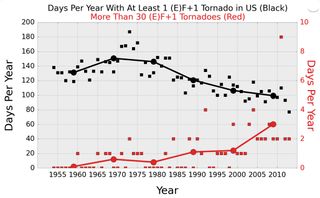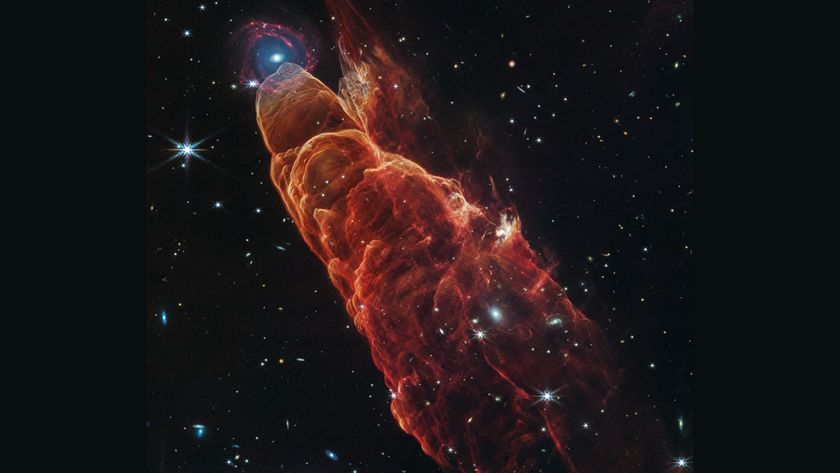Terrifying Tornado Clusters on the Rise

Tornadoes are touching down in clusters more often than 50 years ago, a new study reports. On some days, more than 30 twisters strike the United States.
Even as storms spawn more tornadoes, there are fewer days on which tornadoes occur, according to the study, published today (Oct. 15) in the journal Science. Since the 1970s, the number of days with at least one EF-1 tornado has dropped from a mean (or average) of 150 to 100.
"When people ask, 'Are we getting more tornadoes, are we getting fewer tornadoes, are they later, are they earlier?' — the answer to everything is yes," said lead study author Harold Brooks, senior scientist at the National Oceanic and Atmospheric Administration's Severe Storms Laboratory in Norman, Oklahoma.
While it's clear that something about tornados in the United States is changing, there is no strong evidence that climate change is to blame.
Brooks said the study is a first step toward exploring possible links between new tornado patterns and global warming. "Obviously, we've had a change in the frequency of the number of days of tornadoes, and in some sense that's a reflection of the climate being different than it was," he told Live Science. "But we don't have the primary cause and effect yet." [The Top 5 Deadliest Tornado Years in US History]
Climate change assist?
Tornadoes are born from severe thunderstorms that feed on warm, moist air and from strong winds that change direction with altitude (called wind shear), which rotate the storms. While global warming is expected to increase the atmospheric fuel available for severe thunderstorms, some scientists think the same conditions may also bring weaker wind shear, resulting in a stalemate. However, a climate-modeling study from Stanford published last year contradicts this idea, finding strong wind shear is especially likely in the spring (peak tornado season in the South) as temperatures rise across the United States.
Sign up for the Live Science daily newsletter now
Get the world’s most fascinating discoveries delivered straight to your inbox.
"The climate change signal may be hidden in this idea of more concentrated tornadic activity," said James Elsner, an atmospheric scientist at Florida State University in Tallahassee, who was not involved in either study. Elsner published a similar analysis of U.S. tornado data in August in the journal Climate Dynamics. He concluded that tornadoes are both growing stronger and increasingly arriving in clusters, even as the total number of days with tornadoes held steady.
Brooks and his co-authors documented the shift toward multiple tornado outbreaks by looking at tornadoes of EF-1 intensity and greater between 1954 and 2013, using official tornado records from U.S. Storm Prediction Center.
The Enhanced Fujita scale, or EF scale, ranks tornadoes based on wind speeds and damage. A tornado with wind speeds between 86 and 110 mph (138 and 177 km/h) is usually rated an EF-1. The highest rating is an EF-5. [See the Tornado Damage Scale in Images]
The yearly tornado total has remained stable over time, the researchers discovered. The mean annual rate of tornadoes rated as EF-1 and greater held steady at 495 per year since the mid-20th century, though the total count can swing wildly. The record high, in 2011, was 898 tornados, and the record low, of 311 tornadoes, was recorded in 2002.

Rising risks
Yet even as yearly tornado tallies remained steady, the nature of tornado outbreaks has changed. Now, there are long dry spells between days of terror when huge numbers of tornadoes rack up the yearly count. For example, in 1973, most of the year's tornadoes were spread among 187 tornado days, and only two days had more than 30 tornadoes. But in 2011, there were nine days that had more than 30 tornados, with only 110 tornado days.
The start of tornado season is also changing, lurching back and forth across its March 22 kickoff, the researchers report. The latest and earliest tornado season starts all took place since 1999.
Tornadoes have always had an element of unpredictability, but forecasting technology is keeping up with the new normal, scientists say. "The weather service is now able to pinpoint their [tornado] watches and warnings, make a more specific regional forecast, and cut down on false alarms," Elsner said.
Tornado clusters may have the biggest impact on emergency responders and insurers, who must adjust to covering severe damage across one or more states. "If you have a lot of events, you have to have the resources available to respond to those events," Brooks said. "If the ordinary events don't happen as often, your emergency response stuff is going to sit around, but you're still going to need all of it. That's a lot of power poles to keep stacked around."
Email Becky Oskin or follow her @beckyoskin. Follow us @livescience, Facebook & Google+. Original article on Live Science.












